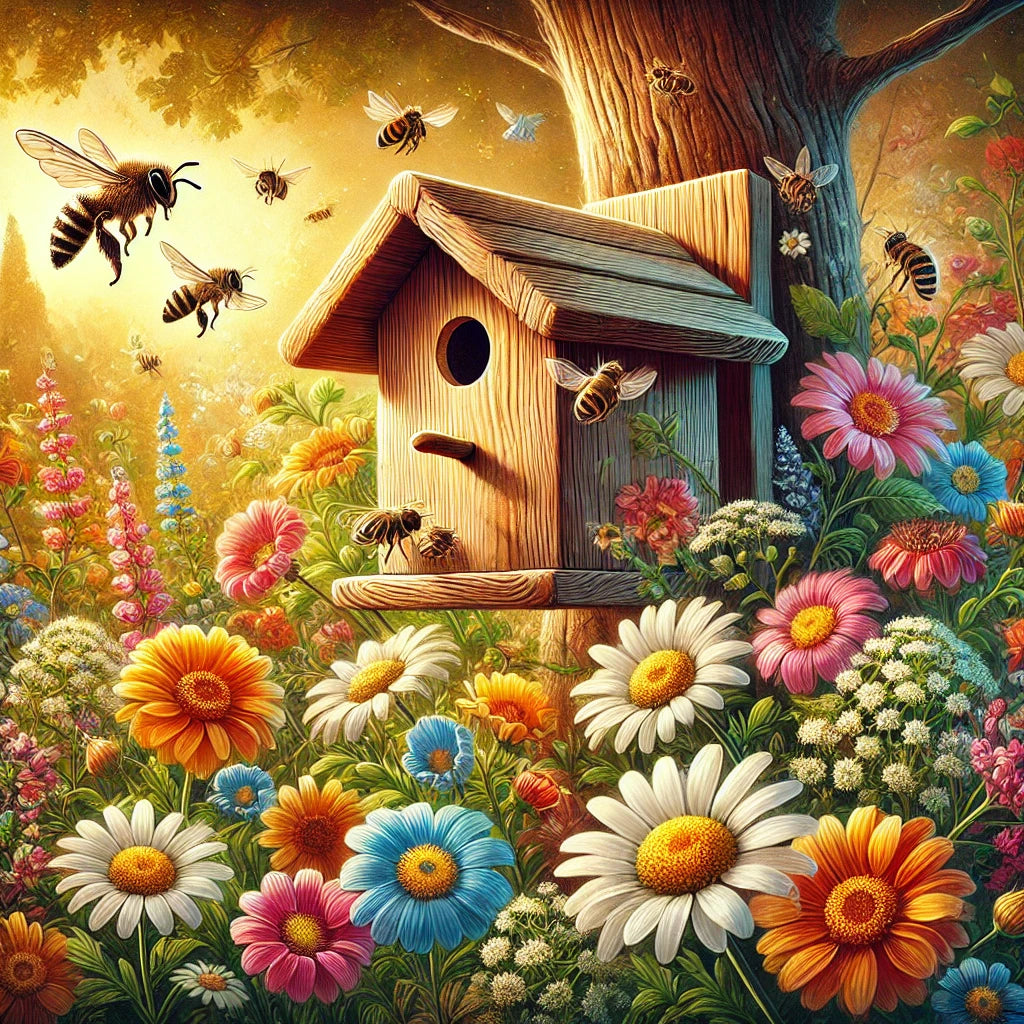Mason bees are incredible pollinators, known for their gentle nature and tireless work in supporting garden health. A Bee Our Guest Bee House is an inviting setup designed specifically for mason bees, providing them with a safe place to nest and thrive.
If you’re interested in bringing these hardworking bees to your garden, this bee house is a perfect addition. Let’s explore the benefits of mason bees, how to set up their ideal habitat, and what makes a bee house the perfect investment for a pollinator-friendly garden.
Why Mason Bees Are the Perfect Garden Guests
Mason bees are solitary, making them unique among pollinators. Unlike hive bees, they don’t swarm and are known for their calm demeanor. Because of their solitary nature, they require very little space and no communal hive. This makes them an ideal guest for gardens, as they quietly work to pollinate flowers, fruits, and vegetables.
The benefits of bees like mason bees include increased plant yield and better garden health, as these bees pollinate far more effectively than honeybees. Mason bees require less maintenance and are friendly neighbors, making them perfect for backyard spaces that prioritize natural pollination and sustainability.
Setting Up Your Bee Our Guest Bee House
The Bee Our Guest Bee House is designed to mimic the natural habitat mason bees seek when looking to lay eggs. Set up your bee house in a sunny spot with some protection from the wind and rain. Mason bees start emerging in early spring, so having a ready-to-go house as the flowers bloom is ideal. To encourage nesting, ensure a mud source nearby, as mason bees use mud to seal their egg chambers.
For those interested in going beyond just a bee house, learning how to start a bee farm can help you support a larger community of pollinators, boosting your garden’s productivity even further.
Tips for Keeping Pests Away from the Bee House
Creating a safe environment for your mason bees means protecting them from pests that can invade their nests. Here are some tips:
- Use Bee Trap Attractant: A bee trap attractant nearby will help keep unwanted visitors like beetles away from the bee house.
- Install Beetle Traps for Beehives: Beetles can damage nests, so placing traps nearby can prevent infestations without harming the bees.
- Regular Cleaning: Cleaning the bee house at the end of each season reduces the chances of mites or parasites disrupting the next generation of bees.
By maintaining a safe habitat, you support a healthy life cycle for mason bees and ensure their ongoing presence in your garden.
Essential Plants to Attract Mason Bees
One way to attract mason bees and enhance their productivity is by planting a variety of flowers and shrubs. Here are some recommended plants:
- Early Bloomers: Lavender, rosemary, and wildflowers provide essential nectar in early spring.
- Fruit Trees: Apple and cherry trees bloom around the same time as mason bees emerge, offering abundant pollen.
- Native Plants: These are usually best suited to your region’s bees, providing natural food sources.
- Herbs and Shrubs: Marigold, thyme, and sage create both food sources and natural pest control, enriching the bee’s habitat.
With these plants surrounding your bee house, mason bees will have a rich environment to pollinate, helping maintain biodiversity and supporting why honeybees and other pollinators are vital to agriculture.
Relocating Your Bee House as Needed
Sometimes, relocating a bee house can benefit your mason bees, especially if the original location becomes shaded or prone to moisture. Bee hive relocation involves moving the bee house to an area with ample morning sun and nearby mud access.
If pests start invading the bee house or if the flowers nearby aren’t attracting bees, relocating to a more suitable spot can help. Consider positioning the bee house in a spot sheltered from wind yet close to pollinator-friendly plants. Relocating a bee house can keep your mason bees safe, enhancing their pollination efforts without stress.
Enhance Your Bee Habitat with Swarm Commander
By adding a Bee Our Guest Bee House to your garden, you’re welcoming an invaluable pollinator that supports plant growth and biodiversity. With simple steps like planting bee-friendly flowers, managing pests, and placing your bee house thoughtfully, you create a space where mason bees can thrive. This setup benefits your garden, encouraging blooms and fruiting plants, while helping sustain pollinators in your area. A bee-friendly garden is a thriving garden, where the gentle hum of bees brings nature to life.
Want to create the perfect home for mason bees? Swarm Commander offers the tools you need to protect and support pollinators. Start building your bee-friendly garden with Swarm Commander today!
Frequently Asked Questions About Mason Bees
Q1. Why should I use a Bee Our Guest Bee House?
This bee house provides a safe, natural space for mason bees to nest and support your garden’s pollination.
Q2. What plants work best to attract mason bees?
Early bloomers like lavender and fruit trees are ideal. Adding native plants and herbs also enhances the bees’ food sources.
Q3. How do I keep pests away from my bee house?
Use bee trap attractants and beetle traps nearby, and clean the bee house annually to deter pests without harming bees.
Q4. Can I move my bee house if it isn’t attracting bees?
Yes, relocating the bee house to a sunnier, sheltered spot may improve bee attraction and nesting success.
Q5. How do mason bees benefit my garden?
Mason bees are excellent pollinators, increasing plant yield and contributing to a healthy, biodiverse garden ecosystem.



